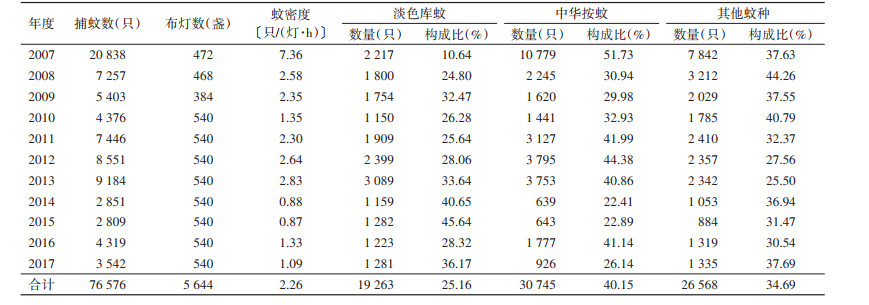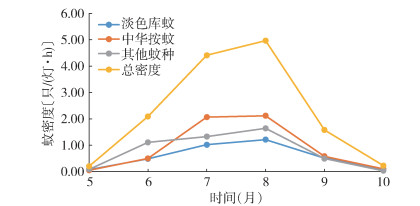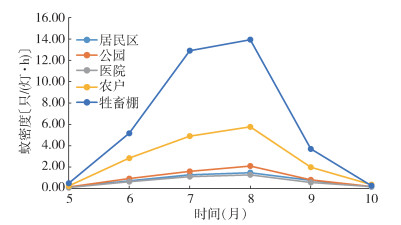扩展功能
文章信息
- 袁爽, 葛涛, 唐磊, 尹世辉, 邢智锋
- YUAN Shuang, GE Tao, TANG Lei, YIN Shi-hui, XING Zhi-feng
- 黑龙江省病媒生物监测点2007-2017年蚊虫监测结果分析
- An analysis of mosquito surveillance results from vector surveillance sites in Heilongjiang province, China, 2007-2017
- 中国媒介生物学及控制杂志, 2021, 32(1): 52-55
- Chin J Vector Biol & Control, 2021, 32(1): 52-55
- 10.11853/j.issn.1003.8280.2021.01.010
-
文章历史
- 收稿日期: 2020-08-21
蚊隶属昆虫纲双翅目长角亚目蚊科,可传播登革热、疟疾、流行性乙型脑炎、丝虫病、黄热病、寨卡病毒病等疾病,是最重要的医学昆虫种类和全球卫生害虫防治的重要对象[1-5]。为了解和掌握黑龙江省蚊虫密度、种群构成和季节消长规律,为蚊虫防制和蚊媒传染病的预防控制提供科学指导依据,黑龙江省在哈尔滨、齐齐哈尔和牡丹江市3个国家级监测点开展了蚊虫监测,2007-2017年一直按照《全国病媒生物监测方案(试行)》[6]开展监测工作。2018年为适应新时期媒介传染病防控的需求,开始按照中国疾病预防控制中心(CDC)2016年颁发的《全国病媒生物监测方案》(国卫办疾控函〔2016〕215号)开展监测工作。现将2007-2017年3个国家级监测点蚊虫监测结果报告如下。
1 材料与方法 1.1 数据来源数据来自黑龙江省病媒生物监测系统中2007-2017年上报的蚊虫监测数据。
1.2 监测点设置在哈尔滨、齐齐哈尔、牡丹江3个地级市城区选择居民区、公园(含街心公园)、医院各3处,农村选择民房和牲畜棚(牛棚和猪圈等)各3处,除牛棚、猪圈外,其他监测点均在外环境中进行。
1.3 监测方法诱蚊灯法,统一采用功夫小帅诱蚊灯(武汉市吉星环保科技有限公司生产,波长2537 Å,功率8 W),于2007-2017年每年的5-10月监测,每月2次,相邻2次间隔15 d,遇风雨天气(风力五级以上)顺延。每处生境选择远离干扰光源且避风的场所作为挂灯点,诱蚊灯光源应距地1.5 m,日落20 min后开启电源,连续诱集6 h,关闭电源,收集蚊虫进行种类、性别鉴定并计数。
1.4 统计学分析应用Excel 2016软件对蚊虫密度、蚊种构成和不同种类、不同生境蚊虫密度等进行统计分析。计算公式:蚊密度〔只/(灯·h)〕=捕获蚊虫数(只)/〔捕蚊时间(h)×灯数〕。
2 结果 2.1 蚊虫总密度及蚊种构成2007-2017年共放置诱蚊灯5 644盏,捕获蚊虫76 576只,总密度为2.26只/(灯·h),其中2007年蚊密度最高,达7.36只/(灯·h),2015年最低,为0.87只/(灯·h),蚊密度除2007年较高外,2008-2017年呈小幅度波浪式下降趋势。蚊虫总构成比以中华按蚊(Anopheles sinensis)最高,占捕获总数的40.15%,淡色库蚊(Culex pipiens pallens)占25.16%。见表 1、图 1。

|

|
| 图 1 2007-2017年黑龙江省病媒生物监测点不同蚊种密度 Figure 1 Density of different mosquito species at vector surveillance sites in Heilongjiang province, 2007-2017 |
| |
2007-2017年蚊虫总密度以中华按蚊最高,为0.91只/(灯·h),淡色库蚊为0.57只/(灯·h)。不同年份中除2014和2015年淡色库蚊密度位于第1位以外,其余年份均以中华按蚊和其他蚊虫密度交替位于前2位。见图 1。
2.3 不同生境蚊密度2007-2017年蚊虫总密度以牲畜棚最高,达6.12只/(灯·h),其次是农户为2.70只/(灯·h),公园、居民区和医院分别为0.97、0.75和0.64只/(灯·h)。不同年份中牲畜棚蚊密度均处于第1位。见图 2。

|
| 图 2 2007-2017年黑龙江省病媒生物监测点不同环境类型蚊虫密度 Figure 2 Density of mosquitoes in different habitats at vector surveillance sites in Heilongjiang province, 2007-2017 |
| |
2007-2017年蚊虫总密度季节消长呈明显单峰曲线,8月达到高峰。各蚊种中中华按蚊和淡色库蚊密度季节消长高峰期集中在7-8月。见图 3。

|
| 图 3 2007-2017年黑龙江省病媒生物监测点不同蚊种密度季节消长 Figure 3 Seasonal fluctuations of different species of mosquitoes from surveillance sites in Heilongjiang in 2007-2017 |
| |
2006-2017年不同生境蚊密度季节消长均呈单峰曲线。牲畜棚蚊密度从7月开始明显升高,8月达到高峰;其他生境均从6月开始缓慢升高,8月达到高峰。见图 4。

|
| 图 4 2006-2017年黑龙江省病媒生物监测点不同生境蚊密度季节消长 Figure 4 Seasonal variation in the density of mosquitoes in different habitats at vector surveillance sites in Heilongjiang province, 2007-2017 |
| |
3个国家级监测点2007-2017年的监测结果显示,蚊虫总密度为2.26只/(灯·h),其中2007年密度最高,达7.36只/(灯·h),2008年以后密度基本维持在相近的水平,且呈波浪式缓慢下降趋势,与监测初期县、区CDC监测人员蚊虫分类鉴定技术不熟练,可能误将诱蚊灯捕获的与蚊虫形态相似的其他昆虫鉴定为蚊虫所致。蚊虫总构成比以中华按蚊所占比例最高,淡色库蚊位于第3位,但在不同年份蚊虫构成比位次不固定,交替出现。据以往调查结果显示,中华按蚊、刺扰伊蚊(Aedes vexans)和淡色库蚊是黑龙江省优势蚊种[7-9],但由于监测方案未将刺扰伊蚊单独列出,统一计入其他蚊虫,因此呈现出中华按蚊、其他蚊虫和淡色库蚊各占1/3左右的构成比。
监测结果显示,黑龙江省蚊虫密度最高的是牲畜棚和农户,表明农村仍是蚊虫最易孳生的环境,城市的居民区、医院和公园蚊虫密度差异较小。由于蚊虫密度受温度和降雨量等气候因素影响较大[10],黑龙江省选择在5-10月开展蚊虫监测,各蚊种、各环境均呈单峰曲线,7-8月是蚊虫活动高峰期。
监测方案中列出的8种蚊虫中,白纹伊蚊(Ae. albopictus)、埃及伊蚊(Ae. aegypti)、雷氏按蚊(An. lesteri)、大劣按蚊(An. dirus)和微小按蚊(An. minimus)黑龙江省近些年一直未监测到,但在全球气候变暖的大趋势下,蚊虫活动范围也在逐渐呈现由南方向北方扩大趋势,持续进行蚊虫生态学监测,及时发现和掌握新入侵蚊种的动态,将对及时应对和有效预防蚊媒传染病具有重要指导意义。
利益冲突 无
| [1] |
吴海霞, 鲁亮, 孟凤霞, 等. 2006-2015年我国蚊虫监测报告[J]. 中国媒介生物学及控制杂志, 2017, 28(5): 409-415. Wu HX, Lu L, Meng FX, et al. Reports on national surveillance of mosquitoes in China, 2006-2015[J]. Chin J Vector Biol Control, 2017, 28(5): 409-415. DOI:10.11853/j.issn.1003.8280.2017.05.001 |
| [2] |
刘起勇. 新时代媒介生物传染病形势及防控对策[J]. 中国媒介生物学及控制杂志, 2019, 30(1): 1-6, 11. Liu QY. Epidemic profile of vector-borne diseases and vector control strategies in the new era[J]. Chin J Vector Biol Control, 2019, 30(1): 1-6, 11. DOI:10.11853/j.issn.1003.8280.2019.01.001 |
| [3] |
孟凤霞, 王义冠, 冯磊, 等. 我国登革热疫情防控与媒介伊蚊的综合治理[J]. 中国媒介生物学及控制杂志, 2015, 26(1): 4-10. Meng FX, Wang YG, Feng L, et al. Review on dengue prevention and control and integrated mosquito management in China[J]. Chin J Vector Biol Control, 2015, 26(1): 4-10. DOI:10.11853/j.issn.1003.4692.2015.01.002 |
| [4] |
孙洪清, 肖宏, 陈良. 重视蚊媒传染病[J]. 医学研究杂志, 2016, 45(9): 1-3. Sun HQ, Xiao H, Chen L. Pay attention to mosquito-borne diseases[J]. J Med Res, 2016, 45(9): 1-3. DOI:10.11969/j.issn.1673-548X.2016.09.001 |
| [5] |
冷培恩. 重视病媒生物控制切断疾病传播途径[J]. 上海预防医学, 2019, 31(8): 615-616. Leng PE. Pay attention to vector biological control and cut off the transmission way of disease[J]. Shanghai J Prev Med, 2019, 31(8): 615-616. DOI:10.19428/j.cnki.sjpm.2019.19704 |
| [6] |
中华人民共和国卫生部.全国病媒生物监测方案(试行)[Z].北京: 中国疾病预防控制中心, 2005. Ministry of Health of the People's Republic of China. National vector surveillance program (trial)[Z]. Beijing: Chinese Center for Disease Control and Prevention, 2005. |
| [7] |
纪卓, 崔昌元, 葛涛, 等. 黑龙江省蚊类调查[J]. 医学动物防制, 1997, 13(5): 293-296. Ji Z, Cui CY, Ge T, et al. Investigation of mosquitoes in Heilongjiang province[J]. J Med Pest Control, 1997, 13(5): 293-296. |
| [8] |
武春光, 刘国平. 黑龙江流域蚊类调查研究[J]. 医学动物防制, 2014, 30(3): 312-313, 316. Wu CG, Liu GP. Investigation of mosquitoes in Heilongjiang River valley[J]. J Med Pest Control, 2014, 30(3): 312-313, 316. DOI:10.7629/yxdwfz201403026 |
| [9] |
杨军, 王晓杰, 张明, 等. 黑龙江省中俄边境口岸蚊类调查研究[J]. 中华卫生杀虫药械, 2014, 20(6): 573-576. Yang J, Wang XJ, Zhang M, et al. Investigation of mosquitoes in frontier ports between Russia and China in Heilongjiang province[J]. Chin J Hyg Insect Equip, 2014, 20(6): 573-576. DOI:10.19821/j.1671-2781.2014.06.022 |
| [10] |
蒋峥, 何建邯, 周莉蓉, 等. 蚊密度与气温及降雨量关系的聚类分析[J]. 中华卫生杀虫药械, 2015, 21(2): 171-172, 174. Jiang Z, He JH, Zhou LR, et al. Cluster analysis on temperature, precipitation and mosquito density[J]. Chin J Hyg Insect Equip, 2015, 21(2): 171-172, 174. DOI:10.19821/j.1671-2781.2015.02.022 |
 2021, Vol. 32
2021, Vol. 32


